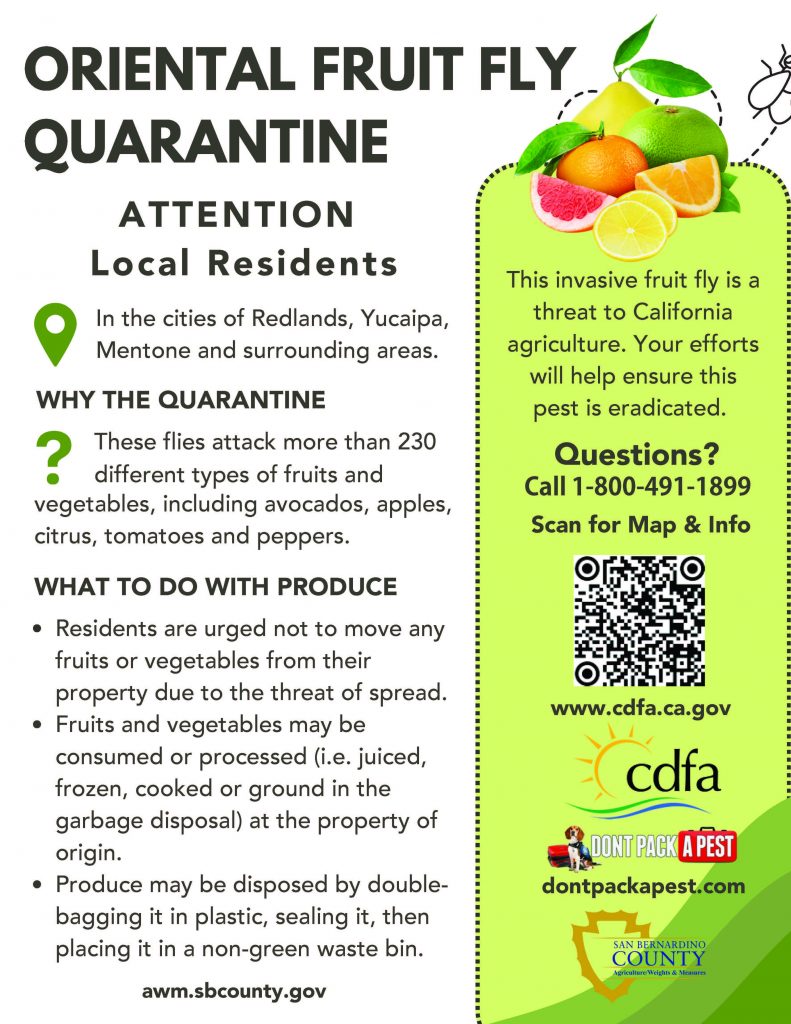
https://plantingseedsblog.cdfa.ca.gov/wordpress/?p=26884
Portions of San Bernardino, Riverside and Sacramento counties have been placed under quarantine for the oriental fruit fly by the California Department of Food and Agriculture following the detection of multiple flies in San Bernardino and Sacramento counties.
In San Bernardino and Riverside counties, detections in and around the city of Redlands have resulted in a quarantine zone covering 112 square miles, bordered on the north by the San Bernardino National Forest; on the south by Highway 60; on the west by Loma Linda; and on the east by Wildwood Canyon. A link to the quarantine map may be found here.
CDFA is the lead agency for the quarantine. The San Bernardino County Department of Agriculture/Weights & Measures assists CDFA by going door-to-door to notify growers and help facilitate outreach and community meetings.
“This year has been a big year for fruit fly detections,” said CDFA Secretary Karen Ross. “The stakes are huge, help us protect our commercial and backyard gardens from invasive fruit flies, please Don’t Pack a Pest or mail packages carrying unmarked fruit and vegetables to California.”
The oriental fruit fly is known to target over 230 different fruit, vegetable and plant commodities. Important California crops at risk include pome and stone fruits, citrus, dates, avocados and many vegetables, particularly tomatoes and peppers. Damage occurs when the female fruit fly lays her eggs inside the fruit. The eggs hatch into maggots, which tunnel through the flesh of the fruit, making it unfit for consumption.
To prevent the spread of oriental fruit flies through homegrown fruits and vegetables, residents living in the quarantine area are urged not to move those items from their property. However, they may be consumed or processed (e.g., juiced, frozen, cooked, or ground in the garbage disposal) on the property where they were picked or disposed of by double bagging and placing in the regular trash, not green waste.
While fruit flies and other invasive species that threaten California’s crops and natural environment are sometimes detected in agricultural areas, the vast majority are found in urban and suburban communities. The most common pathway for these pests to enter the state is by “hitchhiking” in fruits and vegetables brought back illegally by travelers as they return from infested regions of the world or in packages of home grown produce from other countries sent to California. Help protect California’s agricultural and natural resources; please Don’t Pack a Pest when traveling or mailing packages.
The oriental fruit fly is widespread throughout much of the mainland of southern Asia and neighboring islands, including Sri Lanka and Taiwan, and it has invaded other areas, most notably Africa and Hawaii.
Federal, state, and county agricultural officials work year-round, 365 days a year, to prevent, deter, detect and eliminate the threat of invasive species and diseases that can damage or destroy our agricultural products and natural environment. These efforts are aimed at keeping California’s natural environment and food supply plentiful, safe and pest-free.
Residents with questions about the project may call CDFA’s Pest Hotline at 1-800-491-1899. Additional information may be found here: www.cdfa.ca.gov/plant/off.
